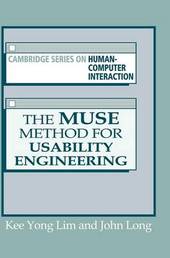
|
The Muse Method for Usability Engineering
Hardback
Main Details
| Title |
The Muse Method for Usability Engineering
|
| Authors and Contributors |
By (author) Kee Yong Lim
|
|
By (author) John B. Long
|
| Physical Properties |
| Format:Hardback | | Pages:352 | | Dimensions(mm): Height 244,Width 170 |
|
| Category/Genre | Computer programming and software development
Human-computer interaction |
|---|
| ISBN/Barcode |
9780521474948
|
| Classifications | Dewey:005.113 |
|---|
| Audience | | Professional & Vocational | |
|---|
| Illustrations |
25 Tables, unspecified; 10 Line drawings, unspecified
|
|
Publishing Details |
| Publisher |
Cambridge University Press
|
| Imprint |
Cambridge University Press
|
| Publication Date |
24 November 1994 |
| Publication Country |
United Kingdom
|
Description
To extend the scope of human factors contributions beyond late evaluation, and so increase their effectiveness and uptake, a frequent plea is for its inputs to be more explicit, early and continuous throughout the system development process. MUSE is a method developed specifically to meet these requirements of Usability Engineering. Since its scope spans user requirements to user interface design, it supports active human factors involvement in both design specification and evaluation. MUSE defines how, what and when particular human factors concerns should be addressed; and specifies the outputs, procedures, notations and documentation involved. Intersections with Software Engineering are identified to support inter-disciplinary project planning, co-ordination and communication (including the use of a common notation). As a structured human factors method, MUSE is arguably the most advanced and complete. This comprehensive book is a text for reference and teaching, and a training manual for method application. It is essential reading for all involved with interactive system development.
Reviews"This extrapolation of a structured human factors method may mark a watershed in usability engineering approaches to design." John F. Meech and Raymond Devlin, Ergonomics
|